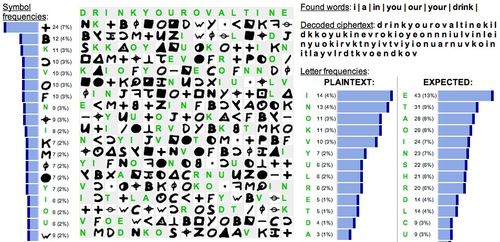Followup to my previous post about free astronomy podcasts:
The American Astronomical Society just posted a big pile of free audio and video of their astronomy sessions. I can’t wait to listen to these!
Followup to my previous post about free astronomy podcasts:
The American Astronomical Society just posted a big pile of free audio and video of their astronomy sessions. I can’t wait to listen to these!
To recreate this strangeness, go to Google Translate, select English to Spanish, type in “Heath Ledger is dead”, hit translate, and bask in the glow of Google’s oddity (at least, for as long as it lasts until they possibly fix it).
(Thanks, Josh, for the story, which he found on 4chan)
I recently finished listening to all of the fascinating lectures in the Silicon Valley Astronomy Lectures series of podcasts. I highly recommend these lectures to anyone that has an interest in astronomy and space exploration. I expected these lectures to be very dry, technical, and boring, but for the most part they were very engaging and directed towards the general public in understandable language. There were some forays into overly obscure technical topics, but overall, the speakers kept things very understandable. And some of them have cool-sounding names, like FRACK-NOY and CROOK-SHANK. The main thing that kept me interested throughout the lectures was feeling the connection to the speakers’ excitement over new space-related discoveries and possibilities. There are just so many awesome space missions going on right now. I felt like a kid again, poring through library books about space, marveling at the explorations of the universe. Yet, it is already 2008 and there are STILL no space colonies (ISS doesn’t count), despite the ambitious claims made by most of the space books from my youth. This cuts me deep. Real deep. *Sniff*.


Oh, groovy 1970s artist renditions of space colonies, why did you never become real?
Nevertheless, the topics of current research and exploration were very interesting. Some examples:



“The past does not exist. There are only infinite renderings of it.”
– Ryszard Kapuscinski, in his book Travels With Herodotus.
Maybe if we keep looking, we’ll eventually see a reflection of a permutation of ourselves, distorted in the endless funhouse mirrors we continue to find as we peer in our vast universe…
Go forth and listen to the lectures for more amazing topics!
P.S.: Here is a bad physics joke told during one of the lectures:
Heisenberg’s uncertainty principle, developed in 1927, states that the simultaneous determination of two paired quantities, for example the position and momentum of a particle, has an unavoidable uncertainty. Some people suspect that when he came up with this principle, Heisenberg may have been having problems with his love life: When he had the time, he didn’t have the energy. And when he had the position, he didn’t have the momentum.
When I was a kid in the 80s poking around on my ol’ Apple //c, I loved the Beagle Bros, a company that made great software and had a very unique style. Their combination of vintage wordcut artwork with hobbyist programming was great fun (here is a great example).
The Beagle Bros company logo depicted the founders as stylized 19th century figures:

My memory of the Beagle Bros was stirred recently when I came across this logo:

Is this company stealing from the iconography of the long-dormant Beagle Bros software empire? Or is this type of logo very common, and I’m just crazy? Wait, don’t answer that.
(by the way, check out the Beagle Bros online museum)
Posted in computing, crackbaby, meaningless, tech, toys
The UK Daily Star confirms that I am not wasting my time with my fruitless pursuits of the Zodiac killer’s unsolved mysteries:
But that’s if [Britney Spears] can tear herself away from the internet where she has been indulging her latest obsession – trying to solve crime.
The star has become fascinated by the unsolved Zodiac killings that took place in California in the late 1960s.
They are the US equivalent of our Jack The Ripper murders. The recent film Zodiac about the case starring Jake Gyllenhaal, 26, captured Britney’s imagination.
She has been spending hours on a website called zodiackiller.com and is convinced she can crack the case as many people believe the culprit is still alive.
Gimme my Cheetos, y’all; We’re gonna crack this thing!!
Another quick update to the Zodiac webtoy: now there are links to flip and rotate the ciphertext. This was a popular feature request that I finally got around to implementing. Enjoy!
I’ve finally made some more updates to the Zodiac webtoy! The biggest change is the addition of simple letter-frequency statistics.

Here is the list of noteworthy changes:
The webtoy seems to be getting much slower in Internet Explorer 6. I’ve not tested it in Internet Explorer 7. But it works pretty well in Firefox and Safari. I am afraid of all the horrible, horrible JavaScript code that I wrote – Please let me know of any problems you find! If you find the new version to be too crappy, you can still use the old version by clicking here.
Posted in computing, meaningless, tech, toys, zodiac
I enjoyed this brief glimpse of the underbelly of Apple’s product marketing. An interviewer asks a touchy question about iTunes acting as a monopoly, and Apple’s PR folks start to freak out:
Such is the ugly reality of companies attempting to control expectations.
From Microsoft’s Help and Support pages:
Computer Randomly Plays Classical Music
View products that this article applies to.
Article ID : 261186
Last Review : March 27, 2007
Revision : 3.3
This article was previously published under Q261186
SUMMARY
During normal operation or in Safe mode, your computer may play “Fur Elise” or “It’s a Small, Small World” seemingly at random. This is an indication sent to the PC speaker from the computer’s BIOS that the CPU fan is failing or has failed, or that the power supply voltages have drifted out of tolerance. This is a design feature of a detection circuit and system BIOSes developed by Award/Unicore from 1997 on.
Anyone remember the famous scene in 2001 when HAL the computer gets shut down?
[HAL’s shutdown]
HAL: I’m afraid. I’m afraid, Dave. Dave, my mind is going. I can feel it. I can feel it. My mind is going. There is no question about it. I can feel it. I can feel it. I can feel it. I’m a… fraid. Good afternoon, gentlemen. I am a HAL 9000 computer. I became operational at the H.A.L. plant in Urbana, Illinois on the 12th of January 1992. My instructor was Mr. Langley, and he taught me to sing a song. If you’d like to hear it I can sing it for you.
Dave Bowman: Yes, I’d like to hear it, HAL. Sing it for me.
HAL: It’s called “Daisy.”
[sings while slowing down]
HAL: Daisy, Daisy, give me your answer do. I’m half crazy all for the love of you. It won’t be a stylish marriage, I can’t afford a carriage. But you’ll look sweet upon the seat of a bicycle built for two.
Apple’s running this obnoxious commercial featuring a possibly bogus airline pilot who, as a passenger on a weather-delayed flight, heroically saves the day by using his magical iPhone to check the weather:
Now, an anecdotal tale has emerged where another guy tried to use his iPhone on a delayed flight to second-guess the airline’s ability to check to weather. He gets a flight attendant to pass his weather prediction on to the pilot, and the pilot’s response over the intercom is hilarious:
“If the passenger with the IPhone would be kind enough to use it to check the weather at our alternate, calculate our fuel burn due to being rerouted around the storms, call the dispatcher to arrange our release, and then make a phone call to the nearest Air Traffic Control center to arrange our timely departure amongst the other aircraft carrying passengers with IPhones, then we will be more than happy to depart. Please ring your call button to advise the Flight Attendant and your fellow passengers when you deem it ready and responsible for this multi-million dollar aircraft and its passengers to safely leave.”
ZING!
I don’t know if the story is true. But, dammit, I still love it.